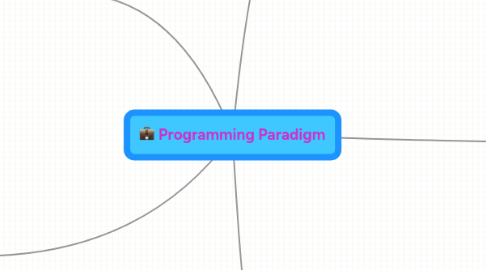Programming Paradigm
by Jacqueline Bene


1. Object-oriented
1.1. Formulates programs as a series of objects and methods that interact to perform a specific task.
1.2. Languages: Smalltalk, C++, Java, Scratch
1.3. Based on the idea that the solution for a problem can be visualized in terms of objects that interact with each other.
1.4. Advantages: Programs define objects, classes, and methods.
1.4.1. Efficient for problems that involve real-world objects
1.5. Disadvantages: Doesn't focus on the generation of procedure-based code.
2. Functional
2.1. Emphasizes the evaluation of expressions, called functions, rather than the execution of commands.
2.2. Languages: LISP, Scheme, Haskell
2.3. An approach to programming that emphasizes the use of expressions called "functions"
2.4. Advantages: If the result of a pure expression is not used, it can be removed without affecting other expressions.
2.5. Disadvantages:If a pure function is called with parameters that cause no side-effects, the result is constant with respect to that parameter list.
3. Procedural
3.1. Emphasizes linear steps that provide the computer with instructions on how to solve a problem or carry out a task.
3.2. Languages: BASIC, Pascal, COBOL, Fortran, Ada
3.3. A program written in a procedural language typically consists of self-contained instructions in a sequence.
3.4. Advantages: Programs detail how to solve a problem.
3.4.1. Very efficient for number-crunching tasks.
3.5. Disadvantages: If the program cannot define the steps for solving a problem.
4. Declarative
4.1. Focuses on the use of facts and rules to describe a problem.
4.2. Languages: Prolog
4.3. Attempts to describe a problem without specifying exactly how to arrive at a solution.
4.4. Advantages:Programs describe the problem.
4.4.1. Efficient for processing words and language.
4.5. Disadvantages: Use a collection of facts and rules to describe a problem.
5. Event-driven
5.1. Focuses on selecting user interface elements and defining event-handling routines that are triggered by various mouse or keyboard activities.
5.2. Languages: Visual Basic, C#
5.3. The programmer is never required to deal with the overall program sequence.
5.4. Advantages: Significantly reduce development time.
5.4.1. Simplify the entire programming process.
5.5. Disadvantages: Omitting a keyword, such as THEN.
5.5.1. Forgetting to close parentheses.
